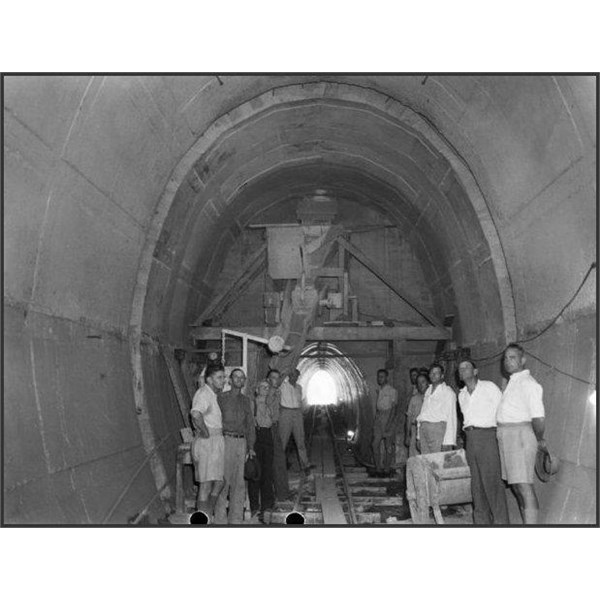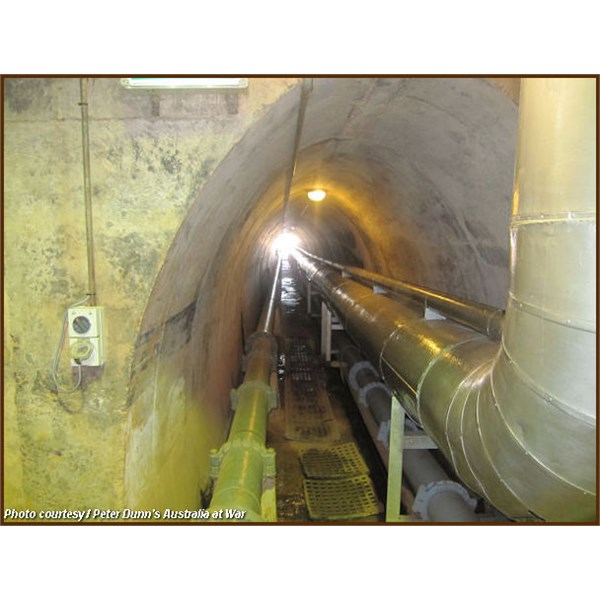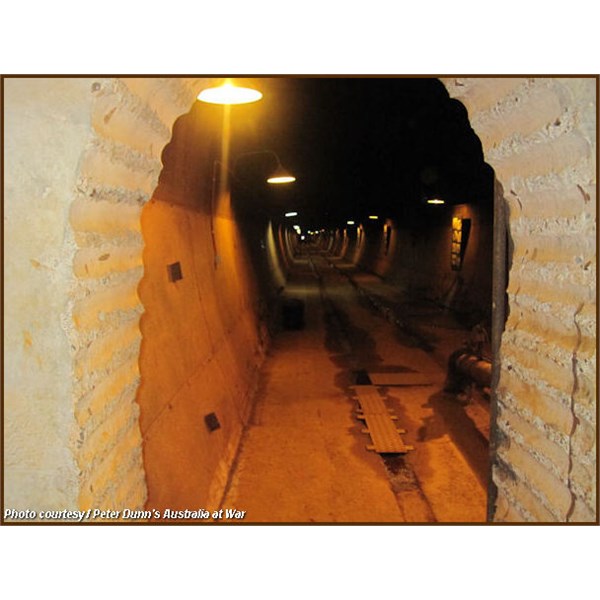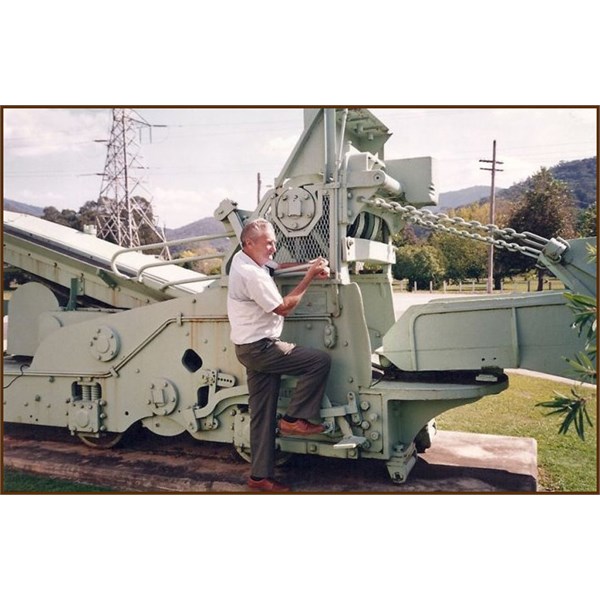The Japanese air raids of 19 February 1942, 16 March 1942 and 16 June 1942 destroyed 7 of the 11 above-ground oil storage tanks that were located on Stokes
Hill Wharf.
Consequently, in November 1942 a decision was made by the Military for the Allied Works Council to construct eight Safe Naval Oil Storage tunnels in
Darwin in the Northern Territory. Five tunnels were eventually built in secret by 400 men of the Civil Constructional Corps (CCC) with work starting in about May 1943. A number of issues were encountered, including flooding, cost increases and engineering problems which meant that only five of the eight proposed tunnels were constructed.
The horseshoe-shaped steel-lined concrete formed tunnels were initially excavated by hand using picks and shovels and hand-held pneumatic tools. The tunnels were then finished off using a Conway Shovel during 1944.

A delegation inspecting tunnelling works at the site

A Conway Shovel on display at Bogong, Vic'
In 1943 contractors Johns and Waygood began work on a series of tunnels running under the escarpment. The tunnels were, on average, designed to be about 15m underground. The longest tunnel, Tank 10, was nearly 200m long. Pipe headings connected the rear ends of the tunnels to an underground pumping station. The tanks were designed to hold distillate, diesel and furnace oil.
A
camp was set up nearby for about 40 workers but estimates of the total manpower required were as high as 400 men. Conditions were tough and contrary to their expectations the men were not paid above award wages or overtime. As a consequence industrial action slowed the construction pace.
The tunnels were lined with concrete and thin steel to prevent cracking under bombardment creating a virtual tank within a tank. By November 1944 the tunnels that still exist today, 1,5,6, 10 and 11 had been lined with welded steel sheeting. Despite these precautions, it became apparent in 1945 that the tunnels leaked. As water seeped between the steel lining and the concrete walls, corrosion set in. Various solutions were attempted but with little success. By the end of the war, estimated costs for the entire project, if completed, would have been
well in excess of £1 000 000.

The Pump Chamber located at the end of the above entrance tunnel

At the end of the entrance tunnel to Oil Storage Tunnels No 5 and 6 looking back towards the entrance on Kitchener Drive

The entrance cut in the wall to Oil Storage Tunnel No. 5
Each of the storage tunnels have an internal width of 4.5 metres and a height of 5.4 metres. The smaller entrance tunnels are 1.96 metres wide by 2.01 metres high and contain a large oil pipe, tank vents, air handling vents and conduits
In the 1950s, tunnels 5 and 6 were used to store jet aircraft fuel for the RAF and RAAF. After about three years and a period of heavy rain the whole system became inoperable because of seepage and was not used again.
A specialised tunnel digging machine known as a Conway Shovel and the men who operated it were moved to
Darwin to help dig the Oil Tunnels. This machine ran on rails along the tunnels, using the bucket at the front to move excavated material onto a
conveyor belt and to the rear, where it could be removed from the tunnel.
Darwin Wharf Tunnel Emergency Exit One of the men working on the Tunnels was Willian Payne who was brought to
Darwin as part of the Civil Constructional Corps, specifically because of his skill in operating the Conway Shovel At the end of the main tunnel an emergency exit leads out to daylight at the base of the cliffs near the Deck Chair Cinema

William Payne
William Payne featured in this photograph operated the Conway Shovel during 1944 in the construction of the World War II Oil Storage tunnels under
Darwin. He was employed with the Allied Works Council, (Civil Construction Corps).

William Payne and the Conway Shovel display at Bogong
At the end of 1943 while William Payne was working for the SEC in tunnels at
Bogong on the Hydro Electric Scheme with the Conway Shovel, he was asked to go to
Darwin and operate the same machine, to help finish the Oil tunnels that were being put underground. On Monday 3rd January 1944 he met Army personnel at the Wodonga Railway Station and travelled by rail to
Melbourne. He left
Melbourne on Sunday 9th January 1944 and travelled in a convoy of Army trucks and vehicles to
Darwin, arriving on Thursday 20th January.
Known as the Drill Runner, William Payne worked on the Oil Tunnels during 1944 on the Conway Shovel. He also worked as a Lorry Driver, for the D.M.R. and carted gravel onto one of the Airstrips that had been bombed by the Japanese.
Cables and
winches, which were driven by electric motors, operated the Conway machine; it moved backward and forward on rails and dug with a bucket in an upward and lifting motion in a radial arch on the face of the tunnel. The material would then be tipped out of the back of the bucket onto a
conveyor belt, which carried it to the rear of the machine and into trolley, which would take the excavated earth out of the tunnel.

Tourist Information sign at the Tunnel Entrance
Without the Hydraulic machines we have nowadays, a
well-developed skill was required by the operator to work the machine efficiently. Operation of the Conway Loader was very mechanical and de-railment had to be avoided. If the machine came off the rails it meant ‘down time’ during the shift as it would have to be lifted back onto the rails by bars with men.
This photograph features the Conway Loader which is stationed on display outside the
Visitor Information Centre, Kiewa Valley Highway, Mt. Beauty, Victoria. This machine was used at
Bogong (Hydro Electric Scheme) and also the Oil Tunnels in
Darwin. The Conway Shovel is British made.
.